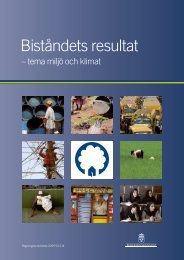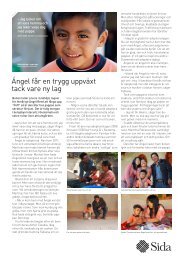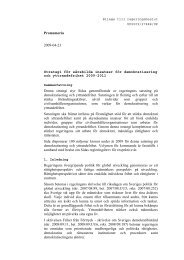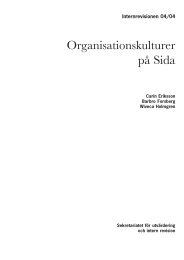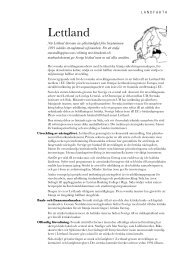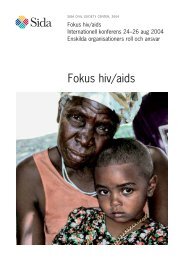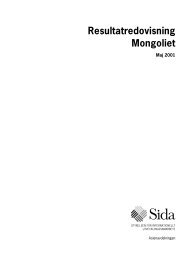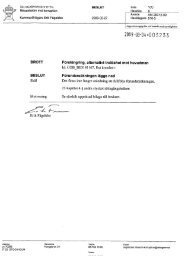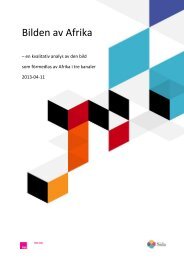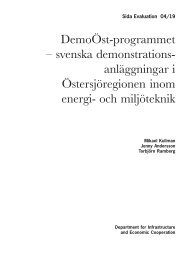Mid-Term Review of the AGIR Programme - Sida
Mid-Term Review of the AGIR Programme - Sida
Mid-Term Review of the AGIR Programme - Sida
Create successful ePaper yourself
Turn your PDF publications into a flip-book with our unique Google optimized e-Paper software.
2 F I N D I N G S<br />
<strong>of</strong>fices, since this area was considered strategic but still very weak in <strong>the</strong> organisation.<br />
In <strong>the</strong> case <strong>of</strong> networks, whilst at <strong>the</strong> central level <strong>the</strong>y can take <strong>the</strong> shape <strong>of</strong> an organisation<br />
(see Forum Mulher), at <strong>the</strong> local level it is a fluid mechanism <strong>of</strong> coordination<br />
<strong>of</strong> multiple organisations, with <strong>the</strong>ir initiatives, different strategic interests, resources<br />
and capacities. In this situation, <strong>the</strong> allocation <strong>of</strong> resources to a network at <strong>the</strong> central<br />
level can be less effective at <strong>the</strong> local level, since <strong>the</strong> fluid nature <strong>of</strong> linkages and mutual<br />
responsibilities between <strong>the</strong> central-level network and <strong>the</strong> local-level organisations<br />
that comprise a network increases <strong>the</strong> risk <strong>of</strong> <strong>the</strong> allocation <strong>of</strong> resources benefitting<br />
only some organisations. Anecdotal evidence ga<strong>the</strong>red in interviews shows that<br />
in some cases, at <strong>the</strong> local level, networks exist thanks to activism <strong>of</strong> a coordinating<br />
organisation that <strong>of</strong>ten uses its own resources to sustain <strong>the</strong> network.<br />
2.5.3 Gender, HIV/Aids, and Human Rights Outcomes - <strong>AGIR</strong> and Cross-Cutting Issues<br />
Within <strong>AGIR</strong>, cross-cutting issues in gender and HIV/AIDS are addressed at:<br />
1) The partners organisational level; and<br />
2) By partners in terms <strong>of</strong> activities relating to <strong>the</strong> general public, citizens, communities<br />
as well as specific target groups under each <strong>of</strong> <strong>the</strong> four <strong>AGIR</strong><br />
<strong>the</strong>mes.<br />
Through joint capacity-building activities held by <strong>the</strong> four intermediaries, training<br />
has been provided that usually focuses on awareness building. Most <strong>of</strong> this training<br />
has been workshop-based and <strong>of</strong> a general standardised nature. In some cases, mainly<br />
among those organisations with already existing gender practices (e.g. Akilizetho),<br />
training was important to improve <strong>the</strong>ir approach on gender and was seen as an opportunity<br />
to do some networking with o<strong>the</strong>r relevant organisations (WLSA and Forum<br />
Mulher). This has led to concrete cooperation initiatives in <strong>the</strong> future.<br />
While gender practices are generally strong in most partner organisations, including<br />
those contacted by <strong>the</strong> review team, in general, capacity streng<strong>the</strong>ning in mainstreaming<br />
gender and HIV/AIDS has led to few results. Knowledge about <strong>the</strong>se issues also<br />
depends on <strong>the</strong> area <strong>of</strong> specialisation <strong>of</strong> <strong>the</strong> organisation. For example, knowledge on<br />
gender is stronger in Forum Mulher and on HIV/AIDS in MONASO than in o<strong>the</strong>r<br />
organisations (see Diakonia 2011 Annual Report). Gender mainstreaming seems to be<br />
most widely integrated in partners’ planning instruments, although this integration<br />
has been a slow process. Some CSO partners expect to have drafted or approved gender<br />
policies by <strong>the</strong> end <strong>of</strong> 2012, including <strong>the</strong> following partners contacted by <strong>the</strong><br />
review team: AAAJC, CTV (Centro Terra Viva, Environmental Organisation) under<br />
SCC.<br />
The joint outcome matrix, filled in by <strong>the</strong> intermediaries, provides mostly generic<br />
information. However Diakonia provides some quantitative measures, which may<br />
illustrate <strong>the</strong> level <strong>of</strong> implementation <strong>of</strong> cross-cutting issue outcomes among <strong>the</strong>ir<br />
partners, as does Oxfam’s annual report for 2011 (May 2012) in which it notes that<br />
only 1 <strong>of</strong>11 partners have an approved gender policy and that 10 <strong>of</strong> 11 partners have<br />
61




